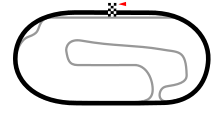1960 Atlanta 500
| Race details[1] | |||
|---|---|---|---|
| Race 44 of 44 in the 1960 NASCAR Grand National Series season | |||
 Layout of Atlanta International Speedway, used until 1996 | |||
| Date | October 30, 1960 | ||
| Official name | Atlanta 500 | ||
| Location | Atlanta International Raceway, Hampton, Georgia | ||
| Course |
Permanent racing facility 1.500 mi (2.400 km) | ||
| Distance | 334 laps, 501.0 mi (804 km) | ||
| Weather | Chilly with temperatures reaching a maximum of 69.1 °F (20.6 °C); wind speeds up to 15 miles per hour (24 km/h) | ||
| Average speed | 108.408 miles per hour (174.466 km/h) | ||
| Attendance | 30,000[2] | ||
| Pole position | |||
| Driver | John Hines | ||
| Most laps led | |||
| Driver | Bobby Johns | Cotton Owens | |
| Laps | 194 | ||
| Winner | |||
| No. 5 | Bobby Johns | Cotton Owens | |
| Television in the United States | |||
| Network | untelevised | ||
| Announcers | none | ||
The 1960 Atlanta 500 was a NASCAR Grand National Series (now Sprint Cup Series) event that was held on October 30, 1960, at Atlanta International Raceway in Hampton, Georgia.
Background
Atlanta International Raceway (now Atlanta Motor Speedway) is one of ten current intermediate track to hold NASCAR races; the others are Charlotte Motor Speedway, Chicagoland Speedway, Darlington Raceway, Homestead Miami Speedway, Kansas Speedway, Kentucky Speedway, Las Vegas Motor Speedway, New Hampshire Motor Speedway, and Texas Motor Speedway.[3] However, at the time, only Charlotte and Darlington were built.
The layout at Atlanta International Speedway at the time was a four-turn traditional oval track that is 1.54 miles (2.48 km) long.[4] The track's turns are banked at twenty-four degrees, while the front stretch, the location of the finish line, and the back stretch are banked at five.[4]
Summary
The transition to purposely-built racers began in the early 1960s and occurred gradually over that decade. Changes made to the sport by the late 1960s brought an end to the "strictly stock" vehicles of the 1950s; most of the cars were trailered to events or hauled in by trucks.
Thirty thousand spectators would attend this live spectacle where Bobby Johns (in his 1960 Pontiac Catalina) would defeat Johnny Allen (in his 1960 Chevrolet Bel Air).[2][5] The race itself took four hours and thirty-six minutes to fully resolve 334 laps; with speeds averaging 108.408 miles per hour (174.466 km/h).[2][5] Fireball Roberts would qualify for the pole position with a speed of 134.596 miles per hour (216.611 km/h).[2] The other top ten finishers were: Jim Paschal, Speedy Thompson, Rex White (officially declared the Grand National Champion that year[6]), Lee Petty, Richard Petty, Joe Weatherly, Bob Welborn and Fred Lorenzen.[2][5]
Bill Gazaway would receive the last-place finish for his collision involving the rear end of his 1960 Oldsmobile vehicle on the first lap of the race;[2][5] making for the shortest NASCAR career in its history. LeeRoy Yarbrough would make his first NASCAR career start here; finishing in 33rd due to a crash on lap 60.[2][5] The record for the shortest NASCAR career would be broken in 1990 by Rich Vogler. He qualified for a 1990 race at Pocono, but he died the night before the race. He was given a 40th-place finish and a "Did Not Start", which means he completed zero laps.
The fewest amount of lead changes were committed here; this record would be officially tied with the 1961 Dixie 400 the following year.
Timeline
- Start of race: Fireball Roberts officially held the pole position as the green flag was waved
- Lap 5: Ned Jarrett's engine stopped working properly
- Lap 16: Friday Hassler's engine stopped working properly
- Lap 23: Wilbur Rakestraw's engine stopped working properly
- Lap 24: Elmo Langley's engine stopped working properly
- Lap 39: Bob Eichor had a terminal crash
- Lap 44: Jack Smith took over the lead from Fireball Roberts
- Lap 46: Marvin Panch's brakes stopped working properly
- Lap 51: Banjo Matthews had a terminal crash
- Lap 52: Tiny Lund's engine stopped working properly
- Lap 58: Jimmy Pardue's engine stopped working properly
- Lap 60: LeeRoy Yarbrough had a terminal crash
- Lap 63: Tommy Irwin took over the lead from Jack Smith
- Lap 65: Joe Weatherly took over the lead from Tommy Irwin
- Lap 83: Johnny Beauchamp took over the lead from Joe Weatherly
- Lap 85: Johnny Beauchamp had a terminal crash
- Lap 86: Joe Weatherly took over the lead from Johnny Beauchamp
- Lap 108: Roscoe Thompson took over the lead from Joe Weatherly
- Lap 110: Bobby Johns took over the lead from Roscoe Thompson
- Lap 144: Roscoe Thompson had a terminal crash
- Lap 154: Jack Smith's engine stopped working properly
- Lap 212: David Pearson had a terminal crash
- Lap 224: Tom Pistone's gas tank stopped working properly
- Lap 255: Doug Yates' fuel pump stopped working properly
- Finish: Bobby Johns was officially credited with the victory
References
- ↑ "1960 Atlanta 500 weather information". The Old Farmers' Almanac. Retrieved 2011-03-11.
- 1 2 3 4 5 6 7 "1960 Atlanta 500 racing results". Racing Reference. Retrieved 2011-03-08.
- ↑ "NASCAR Race Tracks". NASCAR. Retrieved September 2, 2011.
- 1 2 "NASCAR Tracks—The Atlanta Motor Speedway". Atlanta Motor Speedway. Archived from the original on 21 July 2011. Retrieved September 2, 2011.
- 1 2 3 4 5 "1960 Atlanta 500 racing results (third reference)". Race Database. Retrieved 2011-03-12.
- ↑ "1960 NASCAR Grand National Series champion". How Stuff Works. Retrieved 2011-03-11.